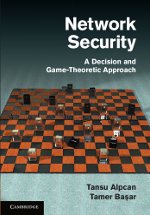Network Security: A Decision and Game Theoretic Approach

This page presents my book “Network Security: A Decision and Game Theoretic Approach” co-authored with Tamer Başar, and published by Cambridge University Press in 2011. Announcements and up-to-date information can be found at the blog of the book. The book is available for purchase at amazon.com, Cambridge University Press, and other retail channels.
Abstract
Network security is a challenging problem due to the complexity of underlying hardware, software, and network interdependencies as well as human and social factors. It involves decision making in multiple levels and multiple time scales, given the limited resources available to both malicious attackers and administrators defending networked systems. The resources vary from bandwidth, computing, and energy at the machine level to manpower and scheduling at the organizational level.
This book presents a theoretical foundation for making resource allocation decisions that balance available capabilities and perceived security risks in a principled manner. Analytical models based on game, optimization, and control theories are studied and applied to diverse network security topics such as attack detection, malware response, algorithm and mechanism design, privacy, and risk management. The presented approach and results are relevant to researchers, graduate students, and practitioners, who are interested in developing a deeper theoretical understanding of the underlying incentive and resource allocation issues in network security.
Endorsements
Network security is a topic of crucial relevance for the information society and has been addressed by many books. Yet, modeling the reasons specific security decisions are made is a research topic still in its infancy. By its unique and in-depth treatment of the subject, this book is a landmark towards this ambitious goal.
Jean-Pierre Hubaux, EPFL, Switzerland.
A decision and game theoretic approach has recently emerged as an important tool for addressing key issues in network security and risk management. This book provides a comprehensive account of this approach by two experts that have pioneered its development and demonstrates its high potential. It should be studied by anyone who aims to develop a thorough and multi-faceted understanding of the subject.
Nick Bambos, Stanford Univ., USA.
Table of Contents
-
PART I: Introduction
-
Chapter 1: Introduction
-
Chapter 2: Network Security Concepts
-
PART II: Security Games
-
Chapter 3: Deterministic Security Games
-
Chapter 4: Stochastic Security Games
-
Chapter 5: Security Games with Information Limitations
-
PART III: Decision Making for Network Security
-
Chapter 6: Security Risk Management
-
Chapter 7: Resource Allocation for Security
-
Chapter 8: Usability, Trust, and Privacy
-
PART IV: Security Attack and Intrusion Detection
-
Chapter 9: Machine Learning for Intrusion and Anomaly Detection
-
Chapter 10: Hypothesis Testing for Attack Detection
-
Appendix: Optimization, Game Theory, and Optimal & Robust Control